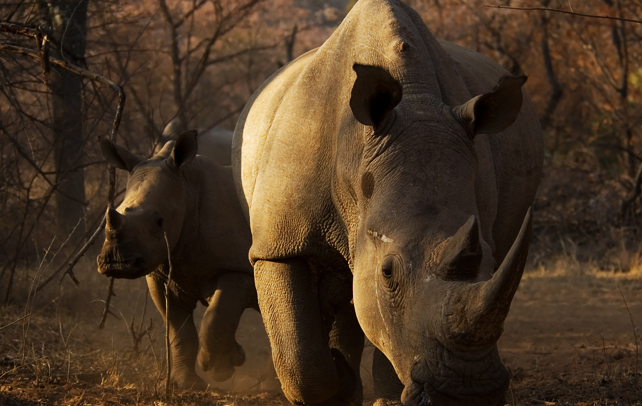Amazing Facts About Rhinoceros

Deriving their name from their horns, rhinoceros are best known for their large size, plate-like skin and not to forget, their horn. Mostly inhabiting the savannahs of Africa and grasslands of Asia, these solitary animals make for the close kins of horses, zebras and tapirs owing to their odd-toed ungulate feature. Currently, there are five different kinds of rhinos — black, white, Sumatran, Javan and Indian rhinos. One of the largest land mammals to have survived on Earth, this 50 million year old species is sadly close to extinction now. All the five species are poached frequently for their prized horn that has led to a considerable drop in their count. Though these solitary browsers appear ferocious, they are basically diffident by nature. They have a thick protective skin, a comparatively small brain and tough horns. A rhino can live up to 40-45 years in captivity while the average age span of a rhino in captivity is 30 years. The facts below give a better overview of this endangered species.
Fast Facts On Rhinoceros
Scientific Name: Black Rhino: Diceros bicornis
White Rhino: Ceratotherium simum
Kingdom: Animalia
Phylum: Chordata
Class: Mammalia
Infraclass: Eutheria
Order: Perissodactyla
Suborder: Ceratomorpha
Superfamily: Rhinocerotoidea
Family: Rhinocerotidae
Size: Over 6 feet tall and more than 11 feet in length
Weight: 750 pounds to 8,000 pounds
Lifespan: Up to around 40-45 years
Habitat: Parts of Africa and Asia
Diet: Vegetation and plants
Gestation: 15-16 months
Interesting And Fun Facts About Rhinoceros
- The rhino is more active during the night and early morning than it is throughout the day.
- A rhino rolls and covers itself in mud in order to prevent from getting sun burnt and also to get rid of blood sucking insects.
- Rhinos have acute auditory and olfactory sense, although the same can’t be said about their visual sense, as they are known to have poor eyesight.
- Like horses, zebras and tapirs, the rhinoceros are odd-toed ungulates. Hence, a rhino is more akin to these equids than hippopotamus.
- Rhinos use their nostril and ears with a form of exhalations and inhalations in order to communicate and express. They have a very gentle way of interaction with fellow rhinos and with other animals also.
- A rhino’s horns do not have a bony core like the cattle’s and antelopes, but they are just compressed keratin which can grow back in a few years if cut.
- The male and female rhinos usually fight during courtship, which leaves serious wound marks on the bodies. After the male and female are done mating, they go their separate ways.
- A rhinoceros can survive for around 4 to 5 days without any water.
- The rhino is a very solitary animal but at times, they do tend to form small groups. Amongst the five different kinds of animals, the white rhino is the most sociable one.
- A female rhinoceros has a gestation period of approximately sixteen months and the females reproduce every 2 to 5 years. The baby calf however cannot live on its own until it reaches an age of three.
- The hump on the back of the rhinos head is a ligament that helps him support its enormous head.
- A rhino can sleep either standing or lying down on the land or in the water.
- A rhino is a very gentle animal, but it gets its violent at times, tends to charge because it cannot see properly, and hence gets startled easily.
- A group of rhinos is called a crash.
- Rhinos are amongst the most endangered species as they are frequently hunted for their horns to treat variety of ailments ranging from fever to food poisoning.
- Both male and female rhinoceros create their own territories and the male rhino not only uses its horns to protect itself from the females, but also from other animals like the lion and hyenas. The fights between the male and female rhinos results in around 50% of male death losses and 30% of female.
- All the different kinds of rhinos are herbivorous and the white rhino even eats plants, which are toxic for other plants hence, clearing out the weeds, which would otherwise be harmful for other plants and animals.
- The adult rhinos are very protective of the calf, and when the calf is under danger, the adult’s rhinos form a circle around the calf in order to protect it.
- A rhino can maintain a speed of 35 miles per hour while running and chasing another rhino.
- The White, Black and Sumatran rhinos have two horns but the Javan and Indian rhinos only have one.
- The rhinos mark their domains by scattering their dung and spraying urine. The dung is spread through the ranged occupied by that group of rhinos.









